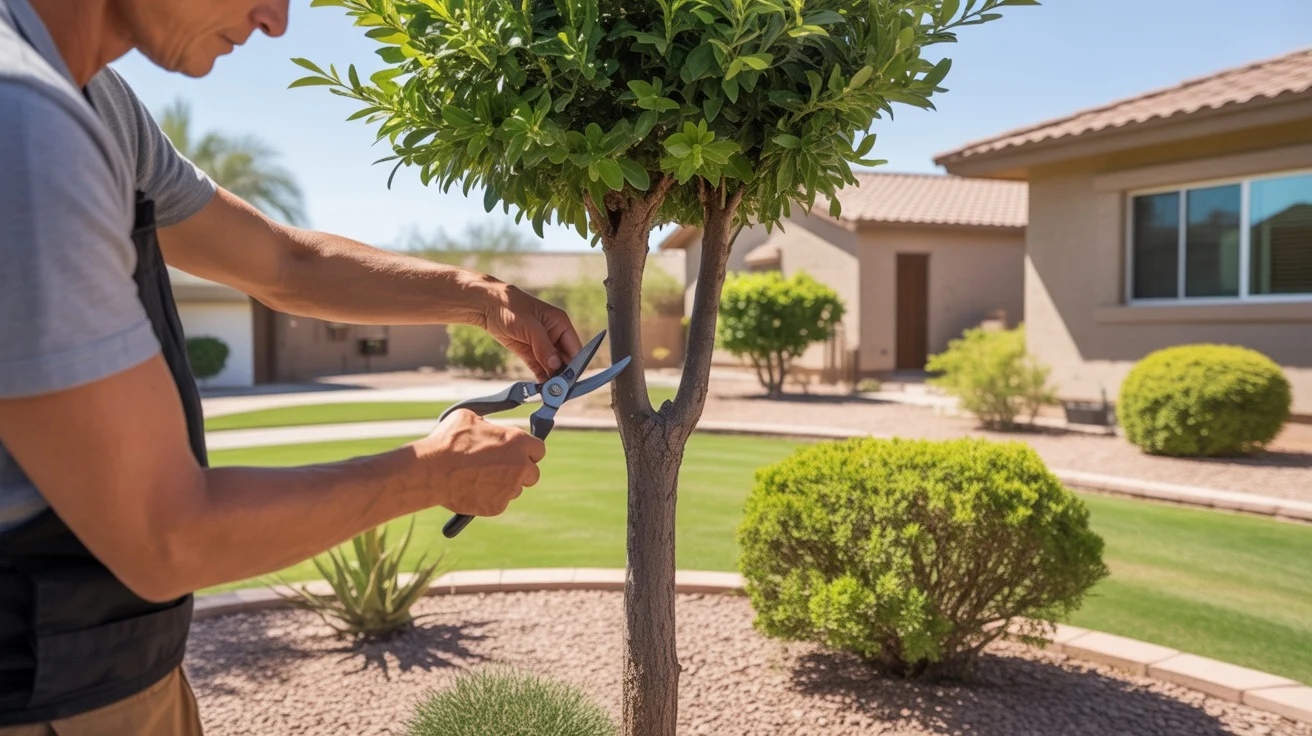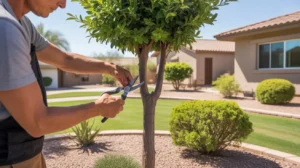Pruning is an essential skill for any Gilbert homeowner looking to maintain a lush, thriving yard. With the right techniques and timing, you can encourage healthy growth, improve plant structure, and enhance the overall appearance of your outdoor space. In this guide, we’ll explore expert pruning tricks tailored to the unique climate and flora of Gilbert.

Understanding the Basics of Pruning
Before diving into specific techniques, it’s crucial to grasp the fundamentals of pruning. The primary goal is to remove dead, damaged, or diseased branches, as well as to control the size and shape of your plants. Proper pruning also promotes air circulation and sunlight penetration, which can help prevent disease and pest issues.
When pruning, always use clean, sharp tools to make precise cuts at a 45-degree angle. This angle allows water to run off the cut surface, reducing the risk of decay. Be sure to disinfect your tools between plants to avoid spreading any potential diseases.
As a general rule, it’s best to prune most plants during their dormant season, typically in late winter or early spring before new growth begins. However, there are exceptions, such as spring-flowering shrubs, which should be pruned immediately after they finish blooming.
Pruning Techniques for Trees
When it comes to pruning trees in Gilbert, the key is to maintain their natural shape while removing any problematic branches. Start by removing any dead, damaged, or crossing branches, as these can be entry points for disease and pests. Next, focus on thinning out the canopy to allow more light and air to reach the interior of the tree.
According to a local arborist, “It’s important to avoid over-pruning your trees, as this can stress the plant and lead to weakened growth. Aim to remove no more than 25% of the live foliage in a single season.” When pruning larger branches, use the three-cut method to prevent bark tearing: make an undercut about 12 inches from the trunk, then an overcut slightly further out, and finally remove the stub at the collar.
For younger trees, focus on establishing a strong central leader and well-spaced lateral branches. Remove any competing leaders and branches that grow at narrow angles, as these are more prone to breakage.
Shaping Shrubs and Hedges
Pruning shrubs and hedges is all about maintaining a desired shape while promoting dense, healthy growth. For formal hedges, use hedge shears to create a crisp, even surface. Prune regularly throughout the growing season to keep the shape in check.
For informal shrubs, use hand pruners or loppers to selectively remove longer branches, encouraging a more natural shape. “The key is to prune back to a lateral branch or bud, which will help the shrub maintain a fuller, more attractive form,” advises a Gilbert landscaper.
When pruning flowering shrubs, be mindful of their blooming cycle. Spring-flowering shrubs should be pruned right after they finish blooming, while summer-flowering shrubs can be pruned in late winter or early spring before new growth begins.
Rejuvenating Overgrown Plants
If you have older, overgrown shrubs or perennials, rejuvenation pruning can help bring them back to a more manageable size and encourage fresh growth. This technique involves cutting the plant back to 6-12 inches above the ground, depending on the species.
While it may seem drastic, rejuvenation pruning can work wonders for plants like lilacs, forsythia, and spirea. Be patient, as it may take a season or two for the plant to fully recover and regain its former glory.
A Gilbert horticulturist suggests, “For less severe cases, you can also try gradual rejuvenation pruning, where you remove about one-third of the oldest stems each year over a three-year period. This approach is less stressful for the plant and allows for a more gradual transformation.”
Pruning for Plant Health
In addition to shaping and size control, pruning plays a vital role in maintaining plant health. Regular pruning helps prevent the spread of disease by removing infected branches and promoting better air circulation.
Be on the lookout for signs of disease, such as discolored leaves, cankers, or oozing sap. When pruning diseased branches, make sure to cut well below the affected area and disinfect your tools between cuts to avoid spreading the pathogen.
Pruning can also help control pest infestations by removing damaged or infested branches. In some cases, thinning out dense foliage can make it easier to spot and treat pest issues before they get out of hand.
Timing Your Pruning
While the general rule is to prune during the dormant season, there are some exceptions to keep in mind. For example, spring-flowering shrubs like azaleas and rhododendrons set their buds the previous year, so pruning in late winter would remove the flower buds.
Similarly, some plants, like oak trees, are best pruned in the heat of summer to minimize the risk of disease transmission. Always research the specific pruning needs of your plants to ensure you’re timing your pruning correctly.
A Gilbert gardening expert advises, “Keep an eye on the weather forecast when planning your pruning tasks. Avoid pruning right before or after extreme weather events, such as heavy frosts or scorching heatwaves, as this can put additional stress on your plants.”
Pruning for Curb Appeal
Beyond the health benefits, strategic pruning can also enhance the aesthetic value of your Gilbert yard. Well-pruned trees and shrubs can create a more polished, inviting appearance that boosts your home’s curb appeal.
Consider the overall landscape design when pruning, and aim to create a balanced, harmonious look. Prune plants to complement architectural features, frame views, or create focal points in your yard.
Remember, pruning is an ongoing process, not a one-time task. By regularly investing time in pruning your Gilbert yard using these expert techniques, you’ll be rewarded with a stunning outdoor space that thrives year after year.











